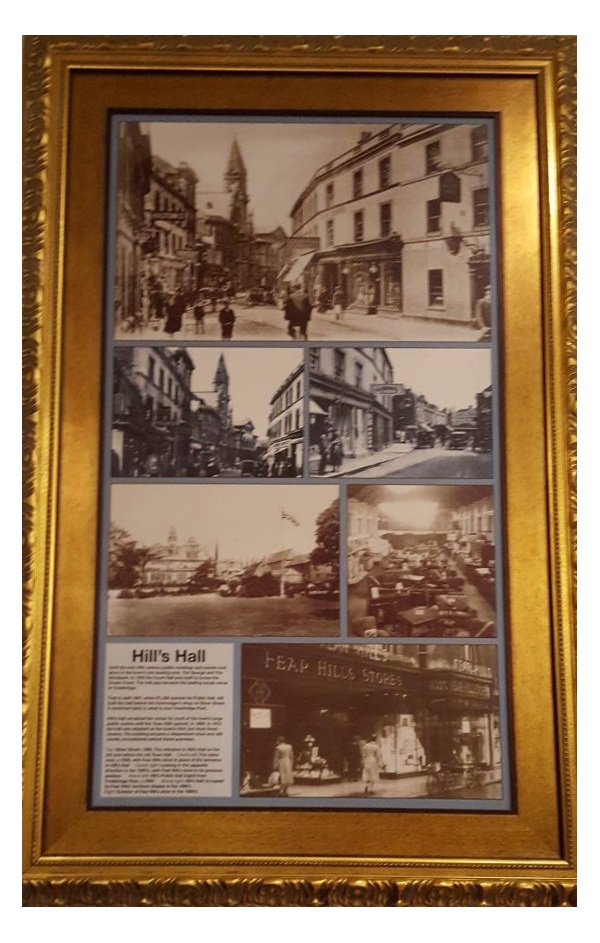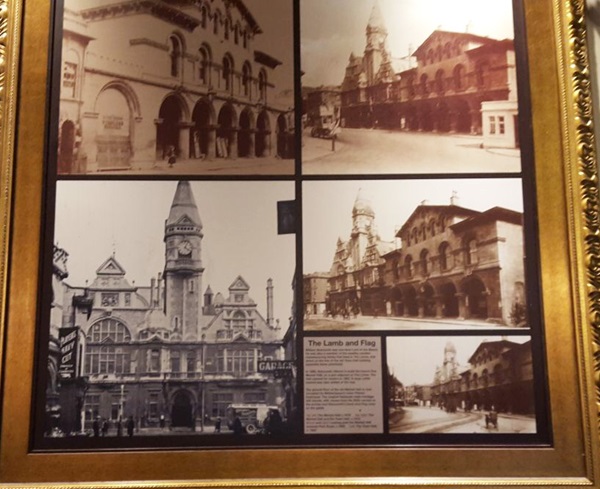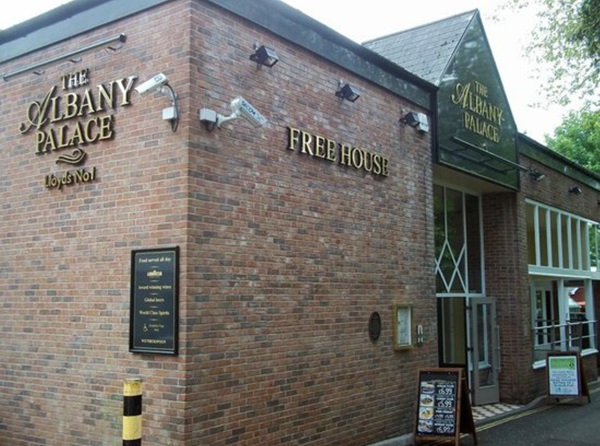Hill’s Hall once boasted a roller-skating rink and in 1910 became the town’s first cinema, known as Albany Ward’s Picture Palace and Skating Rink. In 1913, this was renamed Albany Ward’s Electric Palace of Varieties. Around December 1914, Albany Ward was the operator of the largest cinema circuit in England. He died in 1956. By then, the former Hill’s Hall had been Fear Hill’s department store for more than 30 years. It later became Dingles and is now partly occupied by a ladies’ fashion shop.
A photograph and text about Albany Ward.

The text reads: The first moving pictures in Trowbridge flickered into life at the Town Hall in November 1896. In early December 1910 the Premier Skating Rink at Hill’s Hall in Silver Street was taken over by Albany Ward, who already owned a string of west-country picture palaces. The Palace or Varieties provided cinematic entertainment from 1910-14 when Albany Ward moved to the Palace in Fore Street, later rebuilt as the Gaumont.
Ward was an important pioneer in British cinema and deserves to be much better known. The name Albany Ward was a stage name; his real name was Hannam Edward Bonner. He was born in London in 1879, and sae his first film show in 1896. Soon afterwards he joined the Velograph Company, as principal operator (projectionist). He then toured the provinces showing a version of Queen Victoria’s Diamond Jubilee (1897), with songs and other entertainment, and became the first moving picture exhibitor to reach parts of Devon, Cornwall and Wales. Ward introduced sounds effects to accompany these shows. On 1 January 1900 Ward opened the Empire Theatre in Oxford and in 1906 established his first permanent theatre in Weymouth. He then built up a circuit which he eventually sold to PCT (Provincial Cinematograph Theatres Ltd) in 1920.
Photographs and text about Hill’s Hall.

The text reads: Until the mid-19th century public meetings and events took place in the town’s two leading inns, The George and The Woolpack. In 1852 the Court Hall was built to house the social Crown Court. The hall also became the leading social venue in Trowbridge.
That is until 1867, when PL Hill opened his Public Hall. Hill built the hall behind his ironmonger’s shop on Silver Street. It stretched back to what is now Trowbridge Park.
Hill’s Hall remained the venue for most of the town’s large public events until the Town Hall opened, in 1889. In 1910 the hall was adapted as the town’s first, but short lived, cinema. The building became a department store and still stands, immediately behind these premises.
Top: Silver Street, 1905. The entrance to Hill’s Hall on the left just before the old Town Hall
Centre left: The same view, c1938, with Fear Hills store in place of the entrance to Hill’s Hall
Centre right: Looking in the opposite direction in the 1920s, with Fear Hill’s store in its previous position
Above left: Hill’s Public Hall (right) from Trowbridge Park, c1900
Above right: Hill’s Hall occupied by Fear Hills’ furniture display in the 1950s
Right: Exterior of Fear Hill’s store in the 1950s.
Photographs and text about William Stancomb and the Market Hall.

The text reads: William Stancomb was one-time Lord of the Manor. He was also a member of the wealthy woollen manufacturing family that lived in The Limes, that stood on the site of the old Town Hall building (opposite these premises).
In 1860, Stancomb offered to build the town’s first Market Hall, on a plot adjacent to The Limes. The Hall opened for traders in 1862. A large cattle market was later added at the rear.
The ground floor of the old Market Hall is now occupied by a former Wetherspoon’s freehouse. The original Italianate-style frontage still stands, with verses from the Bible carved on the arches and Stancomb’s Lamb and Flag crest on the gable.
Top left: The Market Hall c1878
Top right: The Market Hall and the Town Hall, c1912
Above and right: Looking past the Market Hall towards Park Road, c1906
Left: The Town Hall, c1932.
Photographs and text about the wool trade.

The text reads: By the mid-1500s Trowbridge was home to many wealthy men whose money came from the woollen cloth trade. These clothiers organised the production of woollen cloth in homes and small workshops.
By the 1700s, in the Georgian era, wealthy Trowbridge clothiers were building fine buildings in The Parade and Fore Street. Mary and Anne, the granddaughters of one of the Town’s clothiers, became Queens of England.
Late in the 1700s machinery for wool production was introduced and shortly after large mills were built to house them. Spinning Jennies, Carding machines and Shearing frames were the first machines.
There were protests against the new machinery, in one of which a mill was burned down. This led to the trial and hanging of Trowbridge man Thomas Hilliker in 1804. He was widely believed to be innocent and a great procession accompanied his body to its burial place in the parish churchyard.
The canal arrived in 1805 with supplies of coal to provide steam to power the new machines. Workers for the factories, which operated 24 hours a day, swelled the population of Trowbridge to around 10,000.
The railway linking the town to Bath and Chippenham arrived in 1848, and by the 1850s there were 17 factories, 3 dye houses and over 30 steam engines to power them. However, competition from Yorkshire Mills meant only 6 of the 17 factories operating in Trowbridge survived until the Second World War.
External photograph of the building – main entrance.

If you have information on the history of this pub, then we’d like you to share it with us. Please e-mail all information to: pubhistories@jdwetherspoon.co.uk